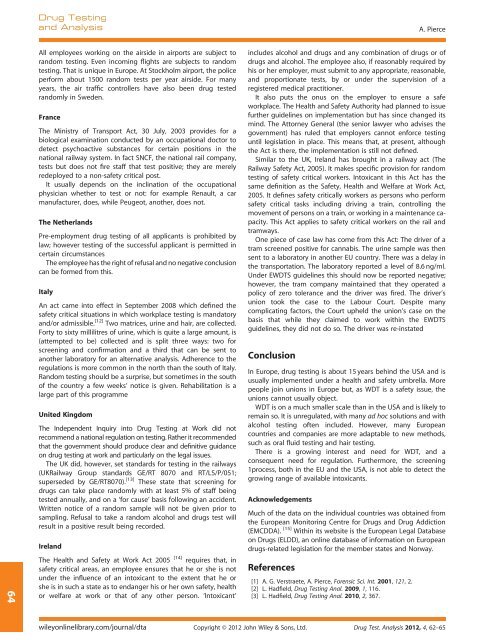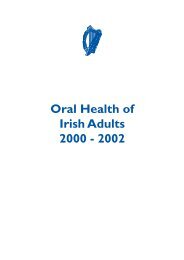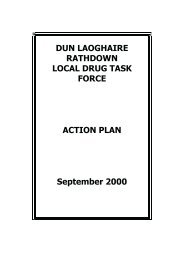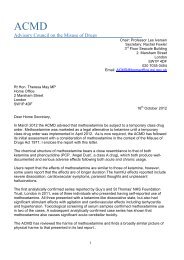Regulatory aspects of workplace drug testing in Europe
Regulatory aspects of workplace drug testing in Europe
Regulatory aspects of workplace drug testing in Europe
Create successful ePaper yourself
Turn your PDF publications into a flip-book with our unique Google optimized e-Paper software.
64<br />
Drug Test<strong>in</strong>g<br />
and Analysis<br />
All employees work<strong>in</strong>g on the airside <strong>in</strong> airports are subject to<br />
random <strong>test<strong>in</strong>g</strong>. Even <strong>in</strong>com<strong>in</strong>g flights are subjects to random<br />
<strong>test<strong>in</strong>g</strong>. That is unique <strong>in</strong> <strong>Europe</strong>. At Stockholm airport, the police<br />
perform about 1500 random tests per year airside. For many<br />
years, the air traffic controllers have also been <strong>drug</strong> tested<br />
randomly <strong>in</strong> Sweden.<br />
France<br />
The M<strong>in</strong>istry <strong>of</strong> Transport Act, 30 July, 2003 provides for a<br />
biological exam<strong>in</strong>ation conducted by an occupational doctor to<br />
detect psychoactive substances for certa<strong>in</strong> positions <strong>in</strong> the<br />
national railway system. In fact SNCF, the national rail company,<br />
tests but does not fire staff that test positive; they are merely<br />
redeployed to a non-safety critical post.<br />
It usually depends on the <strong>in</strong>cl<strong>in</strong>ation <strong>of</strong> the occupational<br />
physician whether to test or not: for example Renault, a car<br />
manufacturer, does, while Peugeot, another, does not.<br />
The Netherlands<br />
Pre-employment <strong>drug</strong> <strong>test<strong>in</strong>g</strong> <strong>of</strong> all applicants is prohibited by<br />
law; however <strong>test<strong>in</strong>g</strong> <strong>of</strong> the successful applicant is permitted <strong>in</strong><br />
certa<strong>in</strong> circumstances<br />
The employee has the right <strong>of</strong> refusal and no negative conclusion<br />
can be formed from this.<br />
Italy<br />
An act came <strong>in</strong>to effect <strong>in</strong> September 2008 which def<strong>in</strong>ed the<br />
safety critical situations <strong>in</strong> which <strong>workplace</strong> <strong>test<strong>in</strong>g</strong> is mandatory<br />
and/or admissible. [12] Two matrices, ur<strong>in</strong>e and hair, are collected.<br />
Forty to sixty millilitres <strong>of</strong> ur<strong>in</strong>e, which is quite a large amount, is<br />
(attempted to be) collected and is split three ways: two for<br />
screen<strong>in</strong>g and confirmation and a third that can be sent to<br />
another laboratory for an alternative analysis. Adherence to the<br />
regulations is more common <strong>in</strong> the north than the south <strong>of</strong> Italy.<br />
Random <strong>test<strong>in</strong>g</strong> should be a surprise, but sometimes <strong>in</strong> the south<br />
<strong>of</strong> the country a few weeks’ notice is given. Rehabilitation is a<br />
large part <strong>of</strong> this programme<br />
United K<strong>in</strong>gdom<br />
The Independent Inquiry <strong>in</strong>to Drug Test<strong>in</strong>g at Work did not<br />
recommend a national regulation on <strong>test<strong>in</strong>g</strong>. Rather it recommended<br />
that the government should produce clear and def<strong>in</strong>itive guidance<br />
on <strong>drug</strong> <strong>test<strong>in</strong>g</strong> at work and particularly on the legal issues.<br />
The UK did, however, set standards for <strong>test<strong>in</strong>g</strong> <strong>in</strong> the railways<br />
(UKRailway Group standards GE/RT 8070 and RT/LS/P/051;<br />
superseded by GE/RT8070). [13] These state that screen<strong>in</strong>g for<br />
<strong>drug</strong>s can take place randomly with at least 5% <strong>of</strong> staff be<strong>in</strong>g<br />
tested annually, and on a ‘for cause’ basis follow<strong>in</strong>g an accident.<br />
Written notice <strong>of</strong> a random sample will not be given prior to<br />
sampl<strong>in</strong>g. Refusal to take a random alcohol and <strong>drug</strong>s test will<br />
result <strong>in</strong> a positive result be<strong>in</strong>g recorded.<br />
Ireland<br />
The Health and Safety at Work Act 2005 [14] requires that, <strong>in</strong><br />
safety critical areas, an employee ensures that he or she is not<br />
under the <strong>in</strong>fluence <strong>of</strong> an <strong>in</strong>toxicant to the extent that he or<br />
she is <strong>in</strong> such a state as to endanger his or her own safety, health<br />
or welfare at work or that <strong>of</strong> any other person. ‘Intoxicant’<br />
<strong>in</strong>cludes alcohol and <strong>drug</strong>s and any comb<strong>in</strong>ation <strong>of</strong> <strong>drug</strong>s or <strong>of</strong><br />
<strong>drug</strong>s and alcohol. The employee also, if reasonably required by<br />
his or her employer, must submit to any appropriate, reasonable,<br />
and proportionate tests, by or under the supervision <strong>of</strong> a<br />
registered medical practitioner.<br />
It also puts the onus on the employer to ensure a safe<br />
<strong>workplace</strong>. The Health and Safety Authority had planned to issue<br />
further guidel<strong>in</strong>es on implementation but has s<strong>in</strong>ce changed its<br />
m<strong>in</strong>d. The Attorney General (the senior lawyer who advises the<br />
government) has ruled that employers cannot enforce <strong>test<strong>in</strong>g</strong><br />
until legislation <strong>in</strong> place. This means that, at present, although<br />
the Act is there, the implementation is still not def<strong>in</strong>ed.<br />
Similar to the UK, Ireland has brought <strong>in</strong> a railway act (The<br />
Railway Safety Act, 2005). It makes specific provision for random<br />
<strong>test<strong>in</strong>g</strong> <strong>of</strong> safety critical workers. Intoxicant <strong>in</strong> this Act has the<br />
same def<strong>in</strong>ition as the Safety, Health and Welfare at Work Act,<br />
2005. It def<strong>in</strong>es safety critically workers as persons who perform<br />
safety critical tasks <strong>in</strong>clud<strong>in</strong>g driv<strong>in</strong>g a tra<strong>in</strong>, controll<strong>in</strong>g the<br />
movement <strong>of</strong> persons on a tra<strong>in</strong>, or work<strong>in</strong>g <strong>in</strong> a ma<strong>in</strong>tenance capacity.<br />
This Act applies to safety critical workers on the rail and<br />
tramways.<br />
One piece <strong>of</strong> case law has come from this Act: The driver <strong>of</strong> a<br />
tram screened positive for cannabis. The ur<strong>in</strong>e sample was then<br />
sent to a laboratory <strong>in</strong> another EU country. There was a delay <strong>in</strong><br />
the transportation. The laboratory reported a level <strong>of</strong> 8.6 ng/ml.<br />
Under EWDTS guidel<strong>in</strong>es this should now be reported negative;<br />
however, the tram company ma<strong>in</strong>ta<strong>in</strong>ed that they operated a<br />
policy <strong>of</strong> zero tolerance and the driver was fired. The driver’s<br />
union took the case to the Labour Court. Despite many<br />
complicat<strong>in</strong>g factors, the Court upheld the union’s case on the<br />
basis that while they claimed to work with<strong>in</strong> the EWDTS<br />
guidel<strong>in</strong>es, they did not do so. The driver was re-<strong>in</strong>stated<br />
Conclusion<br />
In <strong>Europe</strong>, <strong>drug</strong> <strong>test<strong>in</strong>g</strong> is about 15 years beh<strong>in</strong>d the USA and is<br />
usually implemented under a health and safety umbrella. More<br />
people jo<strong>in</strong> unions <strong>in</strong> <strong>Europe</strong> but, as WDT is a safety issue, the<br />
unions cannot usually object.<br />
WDT is on a much smaller scale than <strong>in</strong> the USA and is likely to<br />
rema<strong>in</strong> so. It is unregulated, with many ad hoc solutions and with<br />
alcohol <strong>test<strong>in</strong>g</strong> <strong>of</strong>ten <strong>in</strong>cluded. However, many <strong>Europe</strong>an<br />
countries and companies are more adaptable to new methods,<br />
such as oral fluid <strong>test<strong>in</strong>g</strong> and hair <strong>test<strong>in</strong>g</strong>.<br />
There is a grow<strong>in</strong>g <strong>in</strong>terest and need for WDT, and a<br />
consequent need for regulation. Furthermore, the screen<strong>in</strong>g<br />
1process, both <strong>in</strong> the EU and the USA, is not able to detect the<br />
grow<strong>in</strong>g range <strong>of</strong> available <strong>in</strong>toxicants.<br />
Acknowledgements<br />
Much <strong>of</strong> the data on the <strong>in</strong>dividual countries was obta<strong>in</strong>ed from<br />
the <strong>Europe</strong>an Monitor<strong>in</strong>g Centre for Drugs and Drug Addiction<br />
(EMCDDA). [15] With<strong>in</strong> its website is the <strong>Europe</strong>an Legal Database<br />
on Drugs (ELDD), an onl<strong>in</strong>e database <strong>of</strong> <strong>in</strong>formation on <strong>Europe</strong>an<br />
<strong>drug</strong>s-related legislation for the member states and Norway.<br />
References<br />
[1] A. G. Verstraete, A. Pierce, Forensic Sci. Int. 2001, 121, 2.<br />
[2] L. Hadfield, Drug Test<strong>in</strong>g Anal. 2009, 1, 116.<br />
[3] L. Hadfield, Drug Test<strong>in</strong>g Anal. 2010, 2, 367.<br />
A. Pierce<br />
wileyonl<strong>in</strong>elibrary.com/journal/dta Copyright © 2012 John Wiley & Sons, Ltd. Drug Test. Analysis 2012, 4, 62–65





